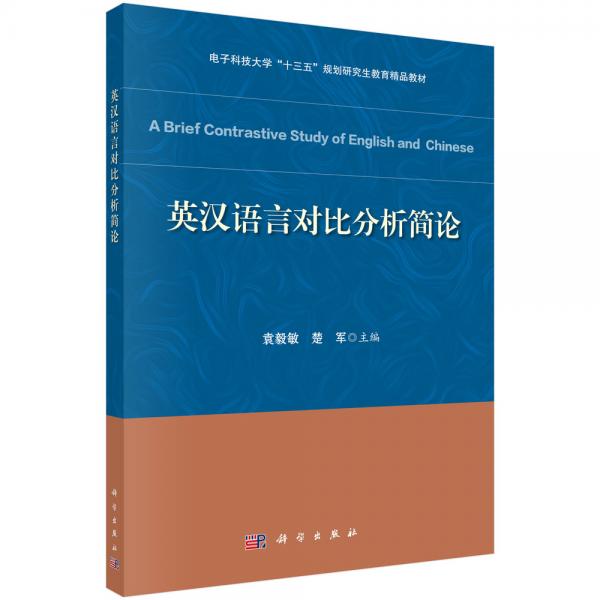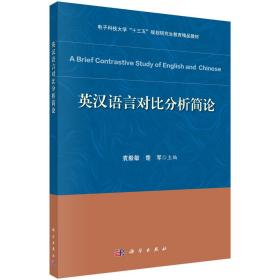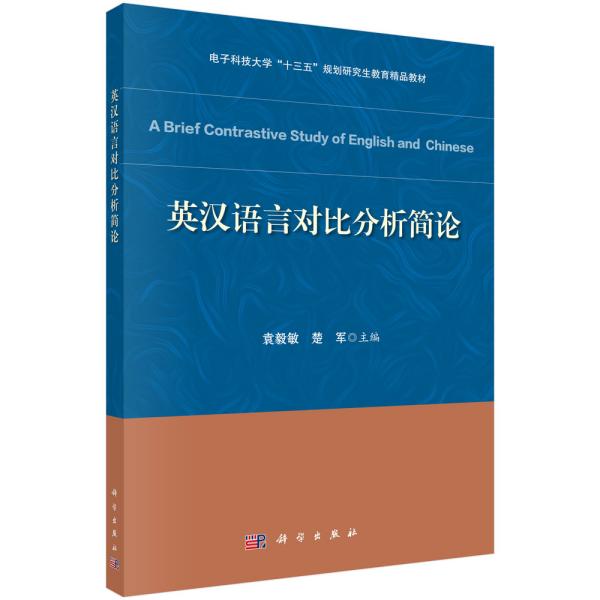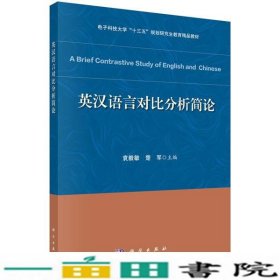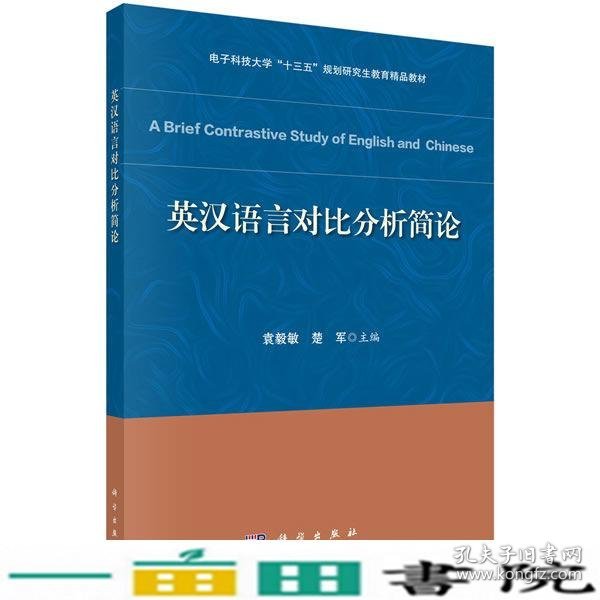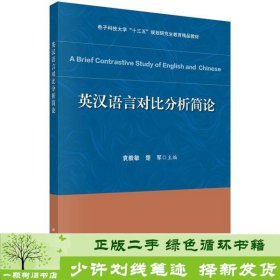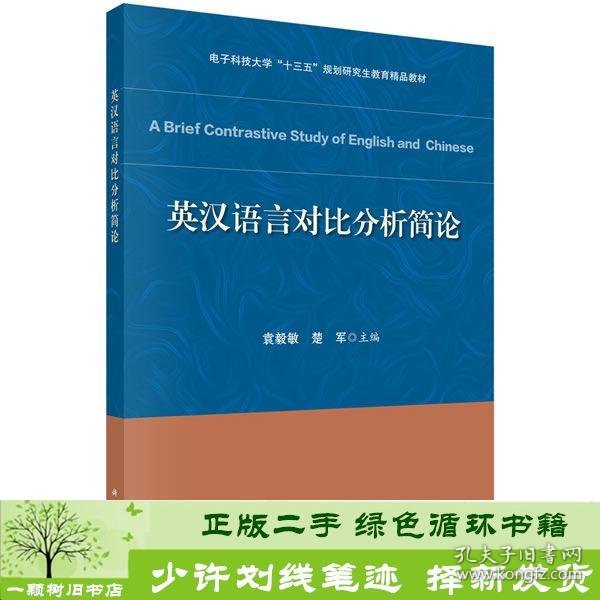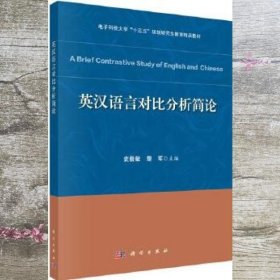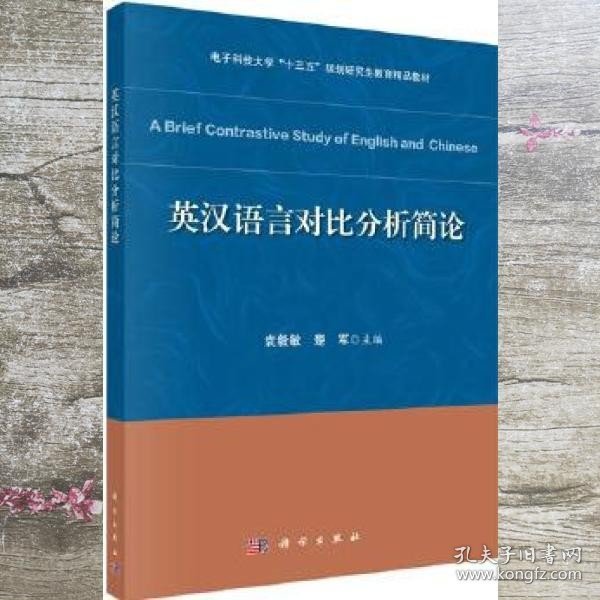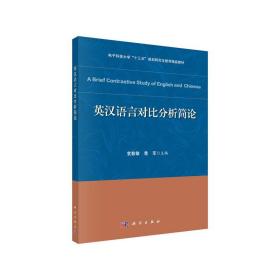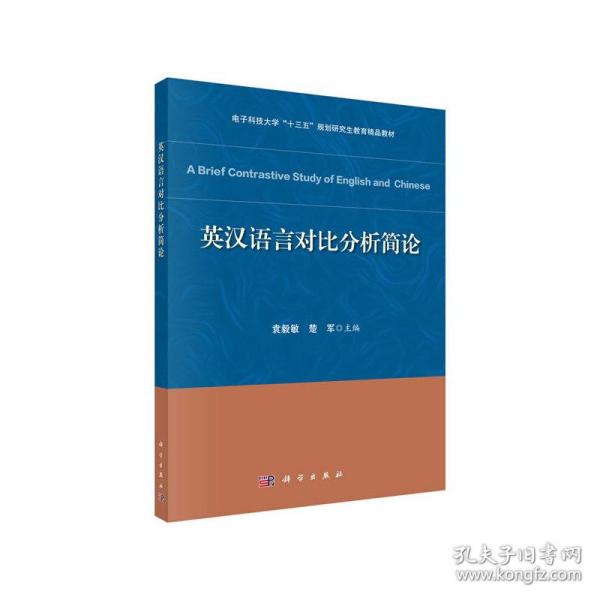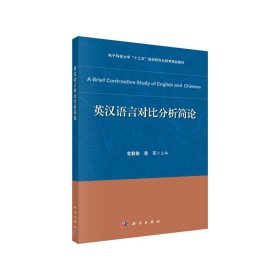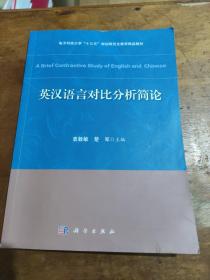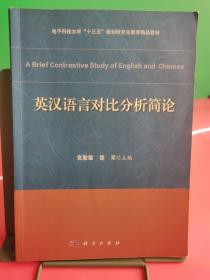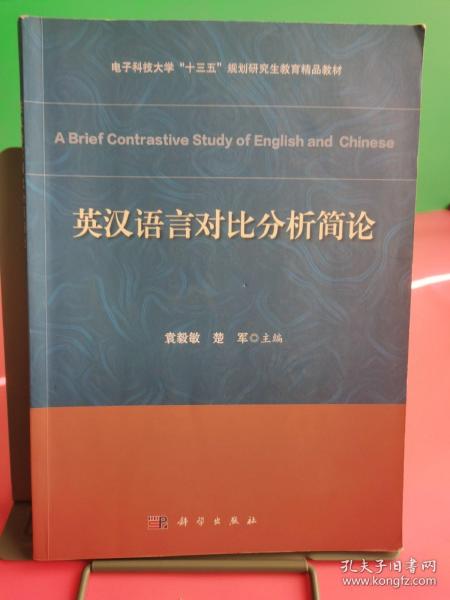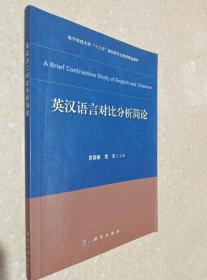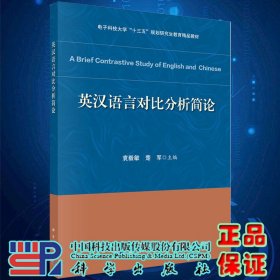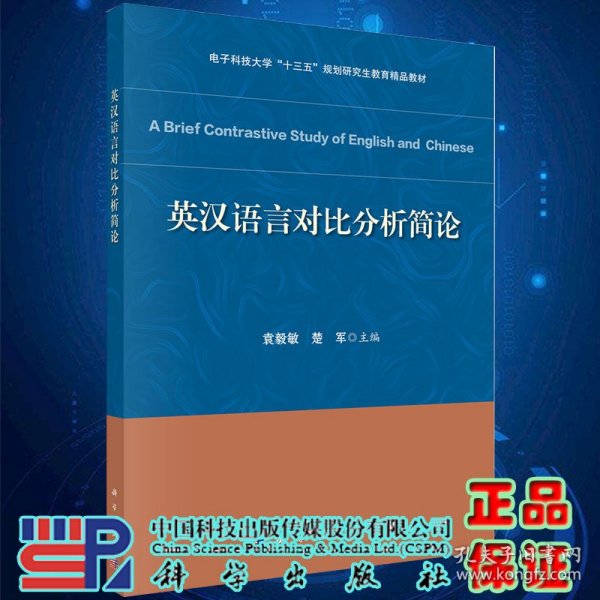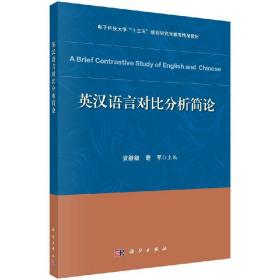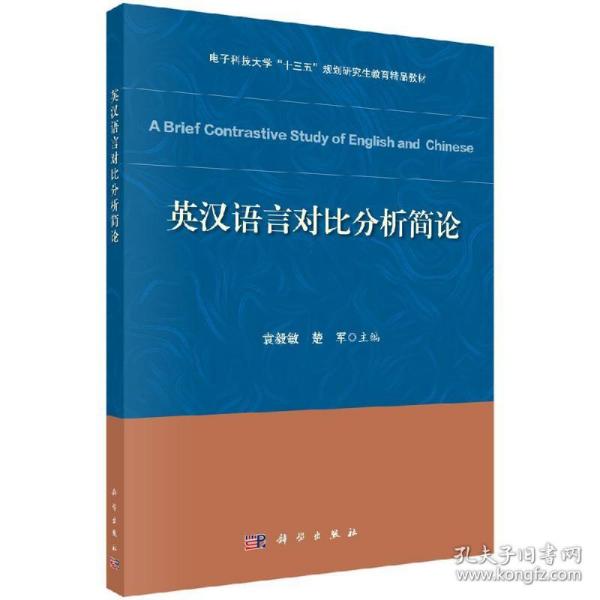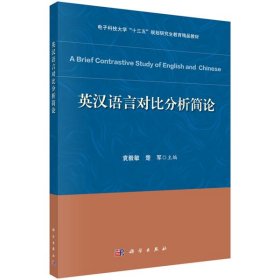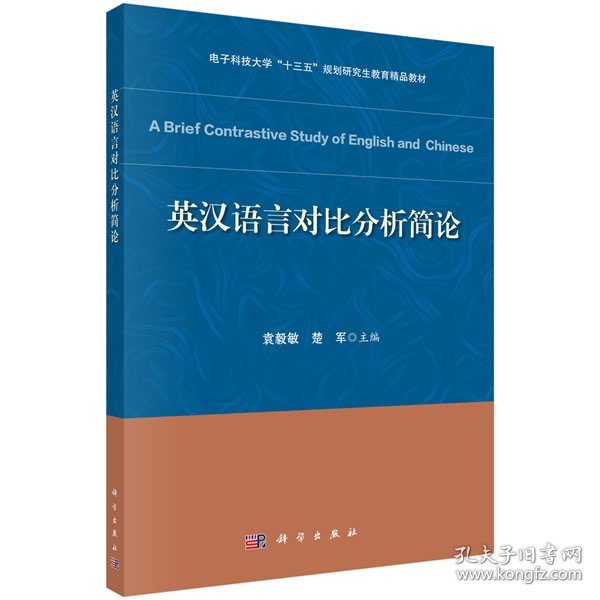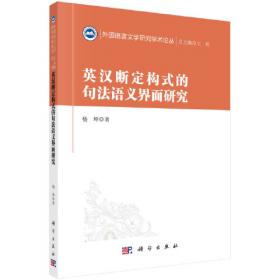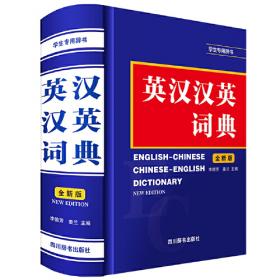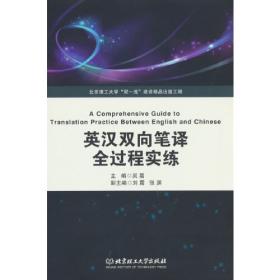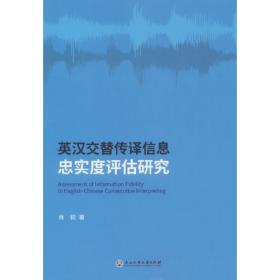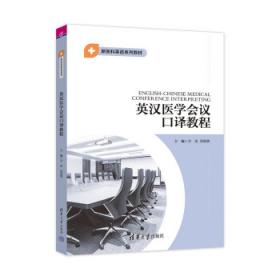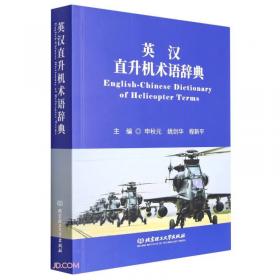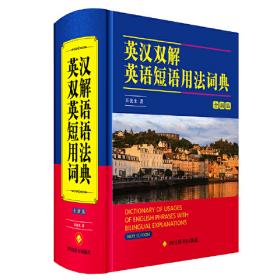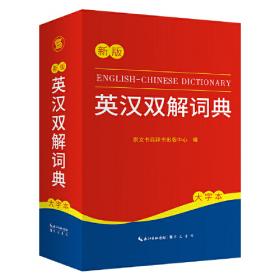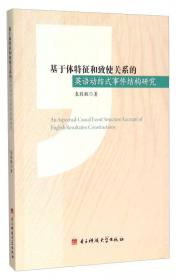英汉语言对比分析简论
出版时间:
2020-06
版次:
1
ISBN:
9787030653086
定价:
78.00
装帧:
平装
开本:
16开
纸张:
胶版纸
页数:
184页
21人买过
-
《英汉语言对比分析简论》从语言的动态与静态、显性与隐性、刚性与柔性、主观与客观,以及抽象与具象五个角度对比分析英汉两种语言的特征。《英汉语言对比分析简论》共分为五个单元,每个单元从基础的语法现象与规则出发,引导学生注意并归纳两种语言在词素、词、句子、篇章等层面上的系统差异,继而激发学生思考这些差异背后的原因,后让学生在真实的语篇环境中去探索和解释目标现象。 Contents
Preface
Unit 1 Stativeness and Dynamicity 1
1. Discussion 1
2. Introduction 1
3. Stativeness and dynamicity in the two languages 1
3.1 Stativeness and dynamicity with different parts of speech 2
3.2 Stativeness and dynamicity in the translation from English to Chinese 8
3.3 Stativeness and dynamicity in the translation from Chinese to English 13
3.4 Reflection 18
4. Extensive analysis 18
4.1 Reading 18
4.2 Discussion 19
Unit 2 Overtness and Covertness 21
1. Discussion 21
2. Introduction 21
3. Overtness and covertness in the two languages 22
3.1 Overtness and covertness with grammar 22
3.2 Overtness and covertness with semantics 23
3.3 Overtness and covertness in the translation from Chinese to English 29
3.4 Overtness and covertness in the translation from English to Chinese 33
3.5 Reflection 40
4. Extensive analysis 41
4.1 Reading 41
4.2 Discussion 42
Unit 3 Rigidity and Flexibility 45
1. Discussion 45
2. Introduction 45
3. Rigidity and flexibility in the two languages 46
3.1 The “rigid” English 46
3.2 The “flexible” Chinese 49
3.3 Rigidity and flexibility in the translation from Chinese to English 53
3.4 Rigidity and flexibility in the translation from English to Chinese 60
3.5 Reflection 68
4. Extensive analysis 69
4.1 Reading 69
4.2 Discussion 72
Unit 4 Subjectivity and Objectivity 73
1. Discussion 73
2. Introduction 73
3. Subjectivity and objectivity in the two languages 74
3.1 Animate subjects vs. inanimate subjects 74
3.2 Active voice vs. passive voice 78
3.3 Subjectivity and objectivity with subjects 83
3.4 Subjectivity and objectivity with voice 89
3.5 Reflection 96
3.6 Extensive analysis 97
4. Extensive analysis 100
4.1 Reading 100
4.2 Discussion 101
Unit 5 Abstraction and Concretion 103
1. Discussion 103
2. Introduction 103
3. Abstraction and concretion in the two languages 104
3.1 Abstract English and concrete Chinese 104
3.2 Translation from abstract English to concrete Chinese 105
3.3 Translation from concrete Chinese to abstract English 108
3.4 Abstraction and concretion in the translation from English to Chinese 110
3.5 Abstraction and concretion in the translation from Chinese to English 114
3.6 Reflection 117
4. Extensive analysis 118
4.1 Reading 118
4.2 Discussion 120
Key to Exercises 122
Unit 1 122
Unit 2 131
Unit 3 147
Unit 4 163
Unit 5 175
References 183
-
内容简介:
《英汉语言对比分析简论》从语言的动态与静态、显性与隐性、刚性与柔性、主观与客观,以及抽象与具象五个角度对比分析英汉两种语言的特征。《英汉语言对比分析简论》共分为五个单元,每个单元从基础的语法现象与规则出发,引导学生注意并归纳两种语言在词素、词、句子、篇章等层面上的系统差异,继而激发学生思考这些差异背后的原因,后让学生在真实的语篇环境中去探索和解释目标现象。
-
目录:
Contents
Preface
Unit 1 Stativeness and Dynamicity 1
1. Discussion 1
2. Introduction 1
3. Stativeness and dynamicity in the two languages 1
3.1 Stativeness and dynamicity with different parts of speech 2
3.2 Stativeness and dynamicity in the translation from English to Chinese 8
3.3 Stativeness and dynamicity in the translation from Chinese to English 13
3.4 Reflection 18
4. Extensive analysis 18
4.1 Reading 18
4.2 Discussion 19
Unit 2 Overtness and Covertness 21
1. Discussion 21
2. Introduction 21
3. Overtness and covertness in the two languages 22
3.1 Overtness and covertness with grammar 22
3.2 Overtness and covertness with semantics 23
3.3 Overtness and covertness in the translation from Chinese to English 29
3.4 Overtness and covertness in the translation from English to Chinese 33
3.5 Reflection 40
4. Extensive analysis 41
4.1 Reading 41
4.2 Discussion 42
Unit 3 Rigidity and Flexibility 45
1. Discussion 45
2. Introduction 45
3. Rigidity and flexibility in the two languages 46
3.1 The “rigid” English 46
3.2 The “flexible” Chinese 49
3.3 Rigidity and flexibility in the translation from Chinese to English 53
3.4 Rigidity and flexibility in the translation from English to Chinese 60
3.5 Reflection 68
4. Extensive analysis 69
4.1 Reading 69
4.2 Discussion 72
Unit 4 Subjectivity and Objectivity 73
1. Discussion 73
2. Introduction 73
3. Subjectivity and objectivity in the two languages 74
3.1 Animate subjects vs. inanimate subjects 74
3.2 Active voice vs. passive voice 78
3.3 Subjectivity and objectivity with subjects 83
3.4 Subjectivity and objectivity with voice 89
3.5 Reflection 96
3.6 Extensive analysis 97
4. Extensive analysis 100
4.1 Reading 100
4.2 Discussion 101
Unit 5 Abstraction and Concretion 103
1. Discussion 103
2. Introduction 103
3. Abstraction and concretion in the two languages 104
3.1 Abstract English and concrete Chinese 104
3.2 Translation from abstract English to concrete Chinese 105
3.3 Translation from concrete Chinese to abstract English 108
3.4 Abstraction and concretion in the translation from English to Chinese 110
3.5 Abstraction and concretion in the translation from Chinese to English 114
3.6 Reflection 117
4. Extensive analysis 118
4.1 Reading 118
4.2 Discussion 120
Key to Exercises 122
Unit 1 122
Unit 2 131
Unit 3 147
Unit 4 163
Unit 5 175
References 183
查看详情
-
英汉语言对比分析简论
正版二手书,批量上传有误差,套装请联系客服再下单,均有笔记不影响使用,无赠品、光盘、MP3等
八五品
山东省济南市
平均发货11小时
成功完成率89.3%
-
八五品
重庆市沙坪坝区
平均发货10小时
成功完成率85.15%
-
英汉语言对比分析简论
正版二手,批量上传数据有误差,套装请咨询客服,均有笔记不影响使用,无赠品、光盘、MP3等
八五品
山东省枣庄市
平均发货11小时
成功完成率86.54%
-
八五品
重庆市沙坪坝区
平均发货10小时
成功完成率74.44%
-
英汉语言对比分析简论
正版二手,均有笔记不影响使用,无赠品、光盘、MP3664等。如需购买套装书,请联系客服核实,批量上传数据有误差,套装书售后运费自理,还请见谅!
八五品
山东省枣庄市
平均发货9小时
成功完成率88.57%
-
英汉语言对比分析简论
买书,就上二手书海官方企业店,清仓处理,真实库存,特价正版,收藏店铺,优先发货! ps:下午三点之前的订单当天发货,之后明天发货,特殊情况除外。
八五品
河南省鹤壁市
平均发货25小时
成功完成率88.38%
-
八五品
河南省鹤壁市
平均发货21小时
成功完成率90.84%
-
八五品
四川省成都市
平均发货11小时
成功完成率91.76%
-
全新
四川省成都市
平均发货25小时
成功完成率88.03%
-
全新
广东省广州市
平均发货19小时
成功完成率86.79%
-
九五品
江西省南昌市
平均发货24小时
成功完成率84.64%
-
八五品
江苏省南京市
平均发货18小时
成功完成率81.79%
-
八五品
山西省晋中市
平均发货7小时
成功完成率93.23%
-
八品
湖南省长沙市
平均发货20小时
成功完成率95.31%
-
八五品
四川省成都市
平均发货9小时
成功完成率97.22%
-
全新
-
八五品
河南省新乡市
平均发货20小时
成功完成率74.34%
-
英汉语言对比分析简论
新华书店全新正版书籍。书名与图片不一致的,以书名为准。个别套装书为单本价格,详情请咨询客服下单。
全新
浙江省杭州市
平均发货13小时
成功完成率76.61%
-
全新
北京市通州区
平均发货40小时
成功完成率71.79%
-
全新
河北省廊坊市
平均发货34小时
成功完成率84.48%
-
八五品
湖南省长沙市
平均发货21小时
成功完成率93.55%
-
八五品
湖南省长沙市
平均发货27小时
成功完成率74.14%
-
全新
北京市通州区
平均发货62小时
成功完成率76.47%
-
八五品
湖南省长沙市
平均发货14小时
成功完成率79.17%
-
八品
湖南省长沙市
平均发货25小时
成功完成率51.72%
-
全新
江西省吉安市
平均发货67小时
成功完成率88.66%
-
九五品
北京市东城区
平均发货30小时
成功完成率83.7%
-
特价!英汉语言对比分析简论
买书,就上织馆萝图书店,特价现货,清仓处理,真实库存,正版书籍,收藏店铺,优先发货! ps:下午三点之前的订单当天发货,之后明天发货,特殊情况除外。
八五品
河南省鹤壁市
平均发货22小时
成功完成率90.04%
-
英汉语言对比分析简论
正版大学教材,清仓处理,真实库存,特价正版,收藏店铺,优先发货! ps:下午三点之前的订单当天发货,之后明天发货,特殊情况除外。
九品
河南省鹤壁市
平均发货12小时
成功完成率93.41%

 占位居中
占位居中

